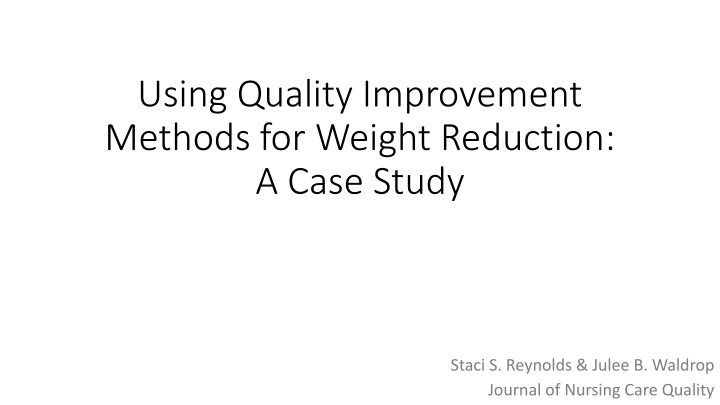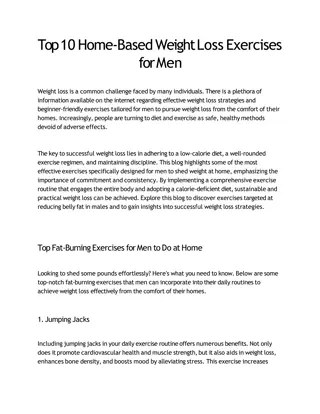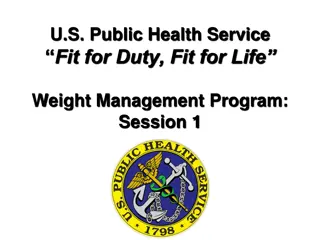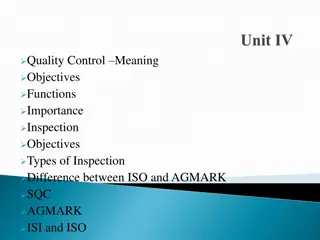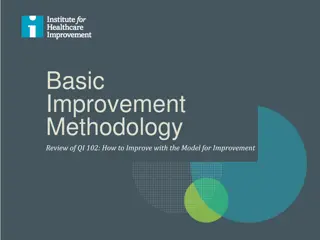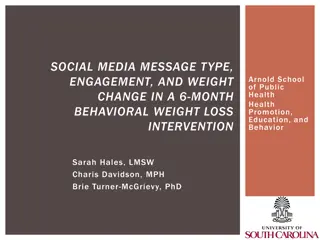Using Quality Improvement Methods for Weight Reduction: A Case Study
This case study focuses on Rebecca, a 42-year-old woman struggling with obesity and limited physical activity. Motivated to lose weight, Rebecca enlists friends to form a quality improvement team aimed at achieving her goal of losing 55 pounds in three months. The study explores the importance of stakeholder buy-in, pitfall avoidance, and setting clear objectives using IHI's Model for Improvement.
Uploaded on Oct 08, 2024 | 2 Views
Download Presentation

Please find below an Image/Link to download the presentation.
The content on the website is provided AS IS for your information and personal use only. It may not be sold, licensed, or shared on other websites without obtaining consent from the author.If you encounter any issues during the download, it is possible that the publisher has removed the file from their server.
You are allowed to download the files provided on this website for personal or commercial use, subject to the condition that they are used lawfully. All files are the property of their respective owners.
The content on the website is provided AS IS for your information and personal use only. It may not be sold, licensed, or shared on other websites without obtaining consent from the author.
E N D
Presentation Transcript
Using Quality Improvement Methods for Weight Reduction: A Case Study Staci S. Reynolds & Julee B. Waldrop Journal of Nursing Care Quality
IHIs Model for Improvement What are we trying to accomplish? How will we know that a change is an improvement? What change can we make that will result in improvement? Act Plan Study Do https://www.ihi.org/resources/how-to-improve
Case Study Rebecca is a 42-year-old woman who is 5 5 and weighs 200lbs with a BMI of 33.3 She works full-time as an administrative assistant at a school of nursing She is sedentary most of the day and has not been physically active because the weather has been cold. She reports eating mostly processed pre-packaged foods, and limited fresh vegetables and fruits. Local Context
Case Study At her annual physical, her primary care provider recommended she lose 55 pounds to be within a healthy weight range. Significance Rebecca is motivated to lose weight as it has become more difficult for her to do activities she enjoys Stakeholder buy-in
Identify the Problem Rebecca s weight (and BMI) place her in the obese category Rebecca is unable to do the activities she enjoys
Pitfall #1: Pitfall #1: Focusing a QI initiative solely on a topic that is interesting, rather than on a problem that needs to be solved
Pitfall #2: Pitfall #2: Implementing a QI initiative that is not a priority to stakeholders.
Case Study QI team Rebecca enlists the support of her friends to help her improve her overall health by reducing her weight and keep her accountable. There are different opinions on what Rebecca s aim should be, with ideas including: Losing weight Losing inches around her waist Building muscle They ultimately decide that Rebecca s aim should be to lose 55 pounds in the next 3 months.
Forming a Team For a health care QI initiative, get input from those who are close to the problem or key stakeholders who can provide valuable information on strategies for improvement. A QI team should include individuals impacted by the change (eg, physicians, nurses, therapists, unit clerks, and patients).
Pitfall #3: Pitfall #3: Failing to form a QI team inclusive of stakeholders.
Creating an Aim Statement A formal aim statement should be developed following the SMART format: Specific Measurable Achievable Relevant Time-bound Ensure the aim is achievable (ie, is losing 55lbs in 3 months achievable?)
Pitfall #4: Pitfall #4: Creating an unrealistic SMART aim.
Case Study To be more achievable, Rebecca s aim is revised to: Rebecca will lose 12 pounds in the next 3 months. Rebecca and her team identify a family of measures; baseline data includes: Weight (outcome) Rebecca weighs 200 pounds Caloric intake (process) Rebecca eats approximately 3000 calories per day Exercise (process) Rebecca gets an average of 6 minutes of exercise each day Satisfaction (balancing) Rebecca identifies operational definitions for each measure
Family of Measures Operational Definition Type Metric (who, what, when, where, how data will be collected) Outcome Rebecca will weigh herself with no clothes on her bathroom scale every Monday right after she gets out of bed and enter this data into the health app on her smart phone. Weight (target: 188lbs) Process Diet (target: 1600 cal/day) Rebecca will monitor her daily caloric intake by inputting all food she eats into the health app in real-time after it is eaten. Process Exercise (target: 30m exercise/day) Rebecca will measure minutes of exercise through the health app on her smart watch daily. Balancing Each week, Rebecca will scan a QR code to a self-developed online survey and will rate her satisfaction with her weight loss plan (diet/exercise) on a 5-point Likert scale. Satisfaction
Creating a Family of Measures QI teams should identify 3-8 measures, including outcome, process, and balancing measures. Outcome measures includes what you are ultimately trying to improve Process measures are logically linked to the outcome Helps teams improve their outcomes Typically show improvements before the outcome measures Generally if process measures are not improving, neither is the outcome measure Balancing measures are unintended consequences, or negative things you did not mean to happen Example: An increase in patient falls as a consequence of a progressive mobility initiative Example: An increase in hospital readmission rates as a consequence of an initiative to decrease the length of stay
Pitfall #5: Pitfall #5: Identifying only one metric to determine success of the QI initiative.
Operational Definitions Operational definitions outline each measure s: Who What When Where How Example: If monitoring hand hygiene compliance: Who will collect this data? What training will they complete? What data will they collect? When will compliance be measured? Where will the data be house? How is compliance determined? How frequently will compliance be measured?
Case Study Brainstorm activity: What are tests of change (interventions) that Rebecca could implement to improve her diet and exercise?
Case Study Rebecca and her friends identify potential changes to her diet and exercise Diet: Rebecca will attend a free nutrition session offered by a licensed nutritionist at the local library Rebecca will swap 2 sandwiches a week for salads Exercise Rebecca will walk indoors for at least 10 minutes during her lunch break 3 times per week
PDSA Cycles QI teams identify potential changes that can result in improvement Often tests of change are focused on process measures QI tools can be used to identify tests of change, such as a Fishbone Diagram, Driver Diagram, Pareto Chart, histogram, or brainstorming Tests of change should be tailored to the local context QI teams should: Plan their tests of change Do (or implement) tests of change Study the data plotted on a run or statistical process control chart Act based on data
Pitfall #6: Pitfall #6: Implementing a passive strategy (eg, education) that is not tailored to the local context.
PDSA 1 PDSA 1 PDSA 1
Case Study After implementing changes, Rebecca studies the updated run charts Weight: 3 pounds lost Caloric intake: reduced to an average of 2860 calories per day Exercise: increased to an average of 11 minutes per day Satisfaction: rated as a 4 out of 5 Activity: should Rebecca keep, modify, or discard her tests of change?
Case Study Rebecca builds upon her previous tests of change and implements the following changes: Diet: cut out all sweets and eat only salads for lunch and dinner Exercise: walk for 15 minutes during her lunch breaks to 5 times a week Data are added to the run charts
PDSA 1 PDSA 2 PDSA 1 PDSA 2 PDSA 1 PDSA 2
Case Study After implementing changes, Rebecca studies the updated run charts Weight: 5 pounds lost Caloric intake: reduced to an average of 1990 calories per day Exercise: increased to an average of 12 minutes per day Satisfaction: rated as a 1 out of 5 To improve her satisfaction and ensure changes are sustainable, Rebecca revises her tests of change
PDSA Cycles Study and Act portions are often overlooked Health care QI teams may fail to study how (or if) tests of change are making an improvement and then act or make modifications Often only a one-time change is made (eg, educational module) Teams may not be flexible in determining if changes should be kept, modified, or discarded
Pitfall #7: Pitfall #7: Implementing only one test of change and not continuing to modify changes based on findings.
Case Study Rebecca conducts 5 PDSA cycles before finding a diet and exercise plan that works
Case Study After implementing changes, Rebecca studies the updated run charts Weight: target weight of 188 reached, but has not been sustained Caloric intake: target of 1600 calories per day not met, but there are signals of improvements: Shift (6+ data points all below the median from days 50-80) Trends (5+ consecutive data points all going down) Exercise: target of 30 minutes of exercise per day met several times; there are signals of improvement: Shift (from days 25-80) Trends Satisfaction: remained 4-5
PDSA 1 PDSA 2 PDSA 3 PDSA 4 PDSA 5
Shift = 6+ points all below the median PDSA 1 PDSA 2 PDSA 3 PDSA 4 PDSA 5
PDSA 1 PDSA 2 PDSA 3 PDSA 4 PDSA 5
PDSA 1 PDSA 2 PDSA 3 PDSA 4 PDSA 5 Shift = 6+ points all below the median
PDSA 1 PDSA 2 PDSA 3 PDSA 4 PDSA 5 Trend = 5+ points all going in the same (positive) direction Trend in the WRONG direction
PDSA 1 PDSA 2 PDSA 3 PDSA 4 PDSA 5
PDSA 1 PDSA 2 PDSA 3 PDSA 4 PDSA 5 Shift = 6+ points all above the median
PDSA 1 PDSA 2 PDSA 3 PDSA 4 PDSA 5 Trend = 5+ points all going in the same (positive) direction Trend in the WRONG direction
Case Study To maintain improvements, Rebecca will need to continue to monitor each outcome, process, and balancing measure over time Changes need to be embedded into her daily routine Monitoring may not need to continue at the same frequency Continuous monitoring can alert Rebecca if any metric starts to trend in an undesirable direction, allowing her to quickly correct or modify her weight loss plan
Sustainability QI teams should celebrate short-term improvements One of the most challenging part of a QI initiative is sustainability Several PDSA cycles are needed to see which version of the improvement works Often QI teams measure metrics twice: Pre-intervention (eg, 3 months baseline) Post-intervention (eg, at the end of 3 months) Conducting pre/post-analyses does not allow teams the opportunity to pivot and modify tests of change that may not be effective
Pitfall #8: Pitfall #8: Failing to measure metrics over time.
Pitfall #9: Pitfall #9: Relying on pre/post-implementation statistical analyses to identify improvements.
Sustainability Pre-post analyses allow clinicians to see if a statistically significant change was identified For Rebecca, statistical analyses revealed significant improvements in her caloric intake and exercise, but not her weight Measure Pre-intervention average 200.8 Post-intervention average 197.1 p-value .067 Weight, in pounds Caloric intake (calories/day) 3078 2562 .001 Exercise, in minutes 6.3 23.5 .001
Sustainability However, Rebecca s weight plotted on a run chart shows signals of improvement This improvement is hidden with p-values and statistical tests
Shift = 6+ points all below the median PDSA 1 PDSA 2 PDSA 3 PDSA 4 PDSA 5
Sustainability Effective tests of change need to be embedded into practice. Sustainability efforts need to be included in the planning of the QI initiative. Consider using the National Health Service (NHS) Sustainability Model to help identify potential barriers to sustainability https://www.england.nhs.uk/improvement-hub/wp- content/uploads/sites/44/2017/11/NHS-Sustainability-Model-2010.pdf
Pitfall #10: Pitfall #10: Failing to develop a sustainability plan early in planning the QI initiative.
References 1.Institute for Healthcare Improvement. How to Improve with the Model for Improvement. Published 2018. Accessed December 24, 2022. https://www.ihi.org:443/education/IHIOpenSchool/resources/Pages/QI-102-How-to-Improve-with-the-Model-for- Improvement.aspx 2.Provost LP, Murray SK. The Health Care Data Guide: Learning from Data for Improvement. 2nd ed. Jossey-Bass; 2022. 3.Dunlap JJ, Waldrop JB. Introduction to Evidence-Based Practice and Quality Improvement for Professional Nursing Practice: A Competency Based Approach. 1st ed. Cognella Academic Publishing; 2024. 4.Bjerke MB, Renger R. Being smart about writing SMART objectives. Eval Program Plann. 2017;61:125-127. doi:10.1016/j.evalprogplan.2016.12.009 5.Reynolds SS, Granger BB. Implementation science toolkit for clinicians: improving adoption of evidence in practice. Dimens Crit Care Nurs. 2023;42(1):33-41. doi:10.1097/DCC.0000000000000556 6.Reynolds S. Using audit and feedback to improve compliance with evidence-based practices. Am Nurse J. 2020;15(10):16-19. 7.Reynolds SS, Waldrop J. Misuse of the p value: using quality improvement analyses to identify clinically significant improvements. Dimens Crit Care Nurs. 2024;43(2):96. doi:10.1097/DCC.0000000000000623 8.Doyle C, Howe C, Woodcock T, et al. Making change last: applying the NHS institute for innovation and improvement sustainability model to healthcare improvement. Implement Sci. 2013;8:127. doi:10.1186/1748-5908-8-127
